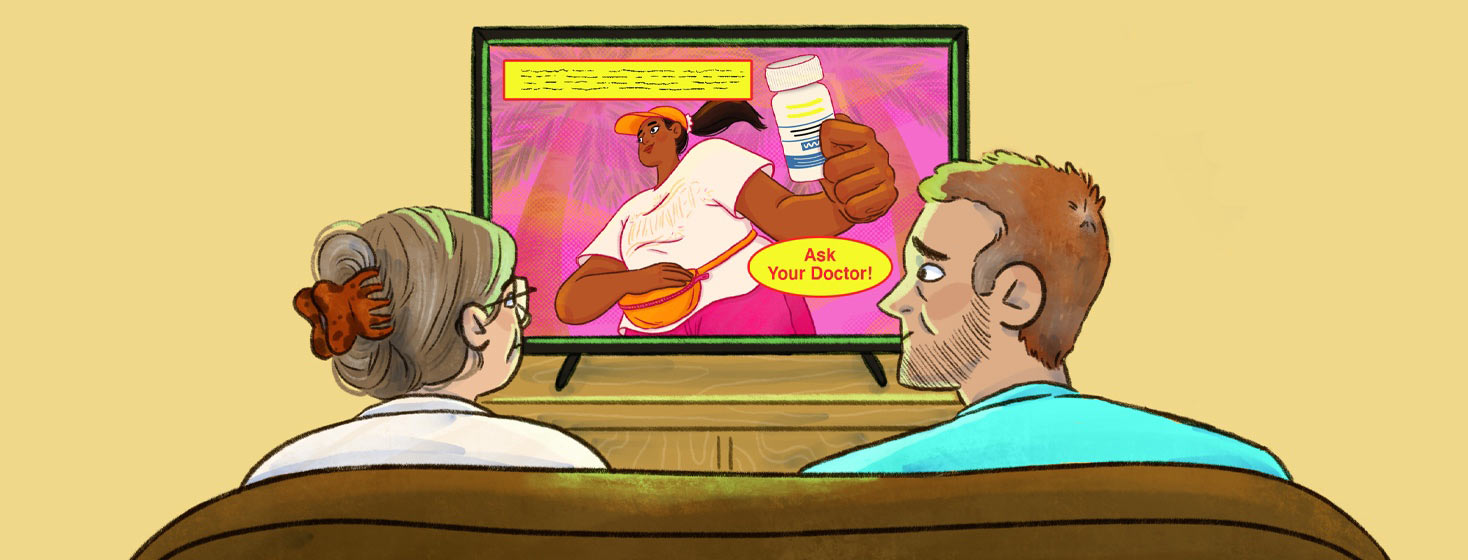Those Commercials!
With a condition like myasthenia gravis (MG), it’s easy to become glued to a recliner and watch way too much television. But it doesn’t even require a condition to develop an "always on" mindset. Whether you are healthy or less so, many of us have a TV or radio in the background most of the time.
And it’s easy to miss the patterns in all that noise. But they are there. Most of what we hear and ignore are commercials. A few weeks ago my hubby and I began to try to listen to them. I didn’t take long to realize that there was a huge increase in ads for prescription meds.
For just a little while, we kept track and realized we had seen 8 ads for new drugs in a 1-hour program, and 2 of them were broadcast twice. From the dancing and singing in the ads, it would be really easy to assume that having serious conditions (from COPD to cancer) was cause for celebration.
Prescription drug advertising
Once upon a time, it was illegal to advertise prescription drugs directly to the consumer. Drug advertisements were mostly targeted towards doctors. Then in 1997, the FDA reduced restrictions to allow pharmaceutical companies to advertise directly to patients. Pharma was able to bypass the physician, going directly to the consumer — who, presumably, could then request the drug. The idea was that the patient would hear the ad and ask the physician for a prescription. The rest is history, as they say.1,2
Since then, we’ve become so used to hearing ads for drugs we are barely conscious of them. "Ask your doctor for ..." That leads, of course, to more ads and more pressure to try them.
Meanwhile, the number of new drugs continues to increase. About 20 novel drugs were introduced in 2016, while about 60 new products were approved in 2018. There were about 50 approvals for novel drugs in 2021.3-5
Before a drug can enter the market it needs extensive testing for safety and efficacy. But what isn’t always clear is why a new drug may be better than its predecessors for the same condition. It may be hard for the physician to say: "You are making good progress under the old prescription" and resist a request to try the new one. (That’s where the ads come in.)6
Ads prompt questions
The drugs that are heavily advertised aren’t always directed at very common problems. So to a certain extent, they serve a public education function. They prompt questions.
In the past year, a new drug has been authorized for seropositive myasthenia gravis. With its release, a bevy of new ads joined the already-full schedule of drug plugs on cable and network television.7
The characters in the ads are often enjoying their hobbies ... gardening, dancing, hiking with the grandchildren. The psychology of the ads can easily confuse the patient and the medical team. We’ve had a half dozen friends ask: "Is that what you have?" That’s good for conversation, but it puts a lot of pressure on us. Now we need to figure out elevator explanations that are accurate but positive.
Drugs and diagnosis
Because the steps to MG diagnosis are long and sometimes twisted, drugs themselves are often used as a way to diagnose. Many members of this community report that they were prescribed Mestinon, for example, "to see if it works." That can leave the diagnosis process open to a sort of Hawthorne Effect. We want it to work so we take a slightly less objective and more rosy view. But with a "butterfly" condition like myasthenia gravis, there are traps. Creating a market for a drug can also create a mindset.
When the physician asks "Is it working?" how do we know that the ads aren’t influencing the answer?
Let your doctor lead the way
As hard as it may seem, it is probably important to ignore those constant ads for drugs in the media. At the very least, we should avoid pressuring for a prescription and let the doctor lead the way. (Believe me, they are well-aware of the availability of the drug. They don’t need a request.)
It is one thing to say: "Would drug X be appropriate for my condition?" and another to say: "Would you prescribe X for me?"
My hubby fell into that trap a few months ago. He asked his neurologist: "What about X (the new drug) for my myasthenia? Would it work better?" His very experienced neurologist answered patiently: "You have made steady progress under the old drug for months. Why risk new side effects?" She could also have explained that the new drug was not fully tested for seronegative patients. The television ad didn’t explain that either.7
What was important was that he asked for, and listened to, good information — not commercials, mailers, or the people in the waiting room.
The fine print
Drug ads presume that we are only half listening. (Probably true.) After the singing, dancing, and pleasant scenes of nature and fun, the last few seconds usually recite the possible side effects at a pace that only an auction addict could understand.
If those side effects were written down, we’d probably be in shock. Of course, similar lists are on that thin paper that the pharmacist gives you too. But we often don’t read those either. Again, your source of information — and balance — should be your doctor, not the ad.
Do your research
Drug ads are not going away. But they should never become your primary source of information. Your physician can recommend good references, and then help you weigh the good and the bad of drugs.
What they can’t do is change the impression that these ads create. So having a collection of good answers and good references is always important.

Join the conversation